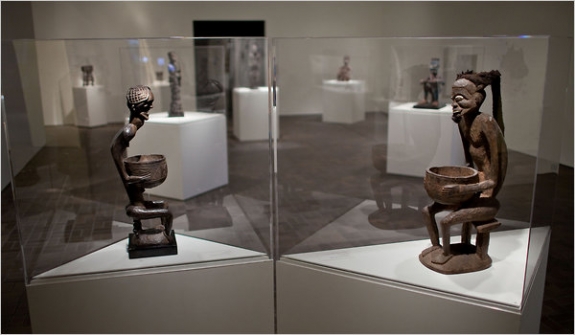To fit African art into Western art history, we had to contain it, tame it. One way was by sorting the art into so-called tribal styles, in much the way we split up the continent into countries. Sure, the divisions were fake, but they gave us a feeling of control.
Then, further in the interest of manageability, we assigned those tribal styles to a sliding scale of value, by which certain kinds of what we called primitive art appeared to be better — meaning somehow more like our own art — than other kinds.
For example, we celebrated the great 15th-century figurative bronzes from Ife in Nigeria for being up to (and, the assumption was, indebted to) our own Renaissance sculpture. And to later, more abstract-looking art, like Dan masks and Fang reliquary figures, we awarded proto-Modernist status because they had provided raw material for Brancusi and Picasso.
Still, in the contest for acceptance some African material had a tough time making the cut. Art from the Republic of Cameroon in West Africa, for example, presented problems. Its formal variety resisted ready packaging. With its tendency toward bold expressiveness, it felt irrepressible and untethered in a way that made advocates for an African classicism nervous.
Of course, much has changed in art history’s attitude toward all of this in the past half-century or so. With that change has come an awareness both of how many opportunities for study have been lost to blinkered thinking, and of how much very basic ground still needs to be explored. And this awareness helps us to see question-asking exhibitions like “Art in Cameroon: Sculptural Dialogues,” at the Neuberger Museum of Art here, for what they are: invaluable.
The show isn’t large: 30 sculptures, with 2 from the Neuberger, and the rest loans from museums and private sources in the United States and Europe. But many of the pieces that the curator, Marie-Thérèse Brincard, has chosen are spellbinders. And she has given them plenty of room to work their magic in an installation made up of isolated sculptures and small clusters of related forms — masks, stools, bowls, carved figures — spaced out over a large gallery.
In this airy arrangement everything is in a spotlight. A small, leopard-shaped bowl that might have been lost in more crowded surroundings shines. A seated carved wood male figure, covered head to foot in a kind of skin-tight Batman costume of colored beads, becomes the eye-grabbing superhero he was meant to be.
At the same time, all the objects work in unison to illustrate the ideas about art from Cameroon set out in the exhibition catalog. At a mere 40 pages, the catalog is closer to a pamphlet than to a book, but it’s packed with information, much of it found in a history-adjusting essay by Christraud M. Geary, senior curator of African and Oceanic art at the Museum of Fine Arts, Boston.



